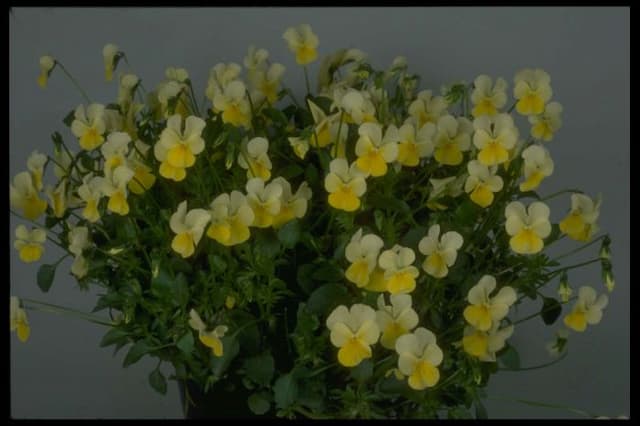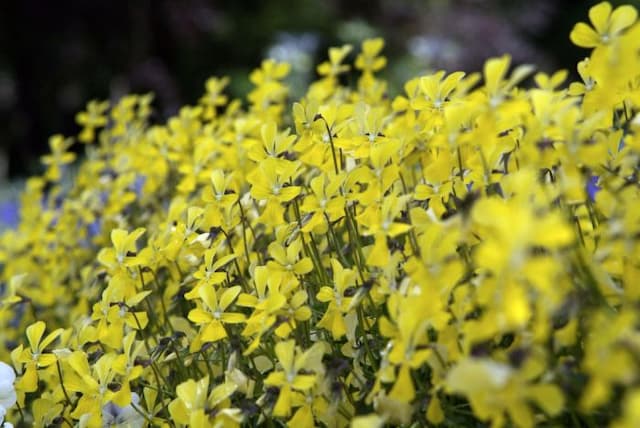Columbine Violet Viola 'Columbine' (Va)

ABOUT
The Viola 'Columbine' is characterized by its charming flowers, which are often a striking point of interest due to their unique shape and brilliant colors. The flowers typically display a blend of two or more hues, often featuring a combination of blue, purple, yellow, or white, creating an enchanting contrast. These blooms possess a distinctive face-like structure, with petals arrayed in a way that resembles a smiling or thoughtful expression, adding to their whimsical appeal. The center of each flower usually has a splash of bright color, which might include a vivid yellow that draws the eye and acts as a stunning focal point. This plant's foliage provides a lush backdrop for the colorful flowers. The leaves are often heart-shaped or rounded, with a slight point at their tips, and they have a soft, almost velvety texture. The color of the leaves can vary from deep green to lighter shades, providing a rich tapestry of greenery throughout the growing season. The contrast between the gentle greens of the leaves and the vibrant colors of the flowers creates visual interest and makes the Viola 'Columbine' a popular choice for gardeners looking to add a touch of whimsy to their outdoor spaces.
About this plant
 Names
NamesFamily
Violaceae
Synonyms
Columbine Violet, Wild Pansy, Columbine Viola
Common names
Viola 'Columbine' (Va)
 Toxicity
ToxicityTo humans
The plant commonly known as Columbine (genus Viola) is not typically known to be toxic to humans. However, it is always advisable to avoid ingesting plants that are not specifically meant for consumption as they can cause adverse reactions in some individuals, such as allergic reactions or gastrointestinal discomfort.
To pets
Columbine (genus Viola) is also not known to be highly toxic to pets. While it is generally considered non-toxic, ingestion of plant material may cause mild gastrointestinal upset in some animals. If you suspect your pet has ingested a large amount of the plant and is showing symptoms of distress, consult your veterinarian.
 Characteristics
CharacteristicsLife cycle
Perennials
Foliage type
Evergreen
Color of leaves
Varies
Flower color
Varies
Height
6 inches (15 cm)
Spread
12 inches (30 cm)
Plant type
Herb
Hardiness zones
4
Native area
Europe
Benefits
 General Benefits
General Benefits- Ornamental Value: Columbine adds aesthetic appeal to gardens with its attractive flowers and foliage.
- Attracts Pollinators: The plant is known to attract bees, butterflies, and other beneficial insects.
- Low Maintenance: Columbine is generally easy to care for and does not require extensive upkeep.
- Cold Tolerant: It can survive in cooler climates, making it suitable for gardens in temperate zones.
- Shade Tolerance: Columbine can grow in partially shaded areas, providing flexibility in garden planning.
- Variety of Colors: Comes in a range of colors, allowing for diverse garden color schemes.
- Self-seeding: The plant can self-propagate, ensuring a continual presence in the garden without additional planting.
 Medical Properties
Medical Properties- Anti-inflammatory: Viola species contain compounds that may reduce inflammation.
- Expectorant: They can help in loosening phlegm and ease congestion.
- Diuretic: Some viola species may increase urine production, potentially aiding in detoxification.
- Antirheumatic: They sometimes are used to help alleviate symptoms of rheumatic conditions.
- Antioxidant: Viola plants may contain antioxidants, which can prevent or delay some types of cell damage.
 Air-purifying Qualities
Air-purifying QualitiesThis plant is not specifically known for air purifying qualities.
 Other Uses
Other Uses- Natural dye: The petals of the Columbine can be used to create natural dyes for fabric, providing a range of colors from yellows to greens depending on the mordant used.
- Art and crafts: Pressed Columbine flowers can adorn greeting cards or be used in scrapbooking for their delicate beauty and interesting shapes.
- Garden aesthetics: Planting Columbine among vegetables can increase the visual appeal of a kitchen garden, blending functionality with ornamental value.
- Floral arrangements: Columbine's unique spurred flowers make unusual and attractive additions to cut flower arrangements, adding both height and interest.
- Edible garnish: The flowers of the Columbine are edible and can provide a decorative, subtly sweet flavor to desserts and salads. (Note: Only consume if sure it's safe and pesticide-free).
- Frost resilience indicators: In climates with fluctuating spring temperatures, the hardiness of Columbine can serve as an indicator for when it is safe to plant less frost-tolerant species.
- Companion planting: Columbines can be planted near taller plants which they can understore with their lower growth habit, filling space with contrasting foliage and flowers.
- Photography subject: The intricate flowers of the Columbine are a popular subject for photography enthusiasts, offering an opportunity to capture their detail and range of colors.
- Wildlife habitat: Columbine plants can provide nectar to hummingbirds and certain butterflies, enhancing biodiversity in gardens.
- Educational tool: Columbines, with their unique flower structure, can serve as an educational tool to demonstrate pollination and plant anatomy to students.
Interesting Facts
 Feng Shui
Feng ShuiThe plant Columbine is not used in Feng Shui practice.
 Zodiac Sign Compitability
Zodiac Sign CompitabilityThe plant Columbine is not used in astrology practice.
 Plant Symbolism
Plant Symbolism- Free-spiritedness: The wild and varied forms of the Columbine flower suggest a spirit of adventure and a love for freedom.
- Foolishness: In the language of flowers, Columbine is sometimes associated with foolishness, likely due to its playful and whimsical appearance.
- Resolve to win: With its ability to grow in tough conditions, the Columbine represents a determination to succeed no matter the odds.
 Water
WaterColumbines prefer consistently moist soil, so water them regularly to keep the soil from drying out completely. The frequency of watering will depend on the climate and weather conditions but typically, watering once every week with about 1 to 1.5 gallons of water per plant should be sufficient. During hot, dry periods, you may need to water more frequently. Avoid overhead watering to minimize the risk of leaf diseases; instead, use a soaker hose or drip irrigation to deliver water directly to the base of the plant.
 Light
LightColumbines thrive best in locations with partial shade, although they can tolerate full sun in cooler climates. The best spot for Columbine plants would be an area that receives morning sunlight and afternoon shade, protecting them from the intense heat of the day. Providing dappled sunlight under the canopy of trees is also ideal to mimic their natural woodland habitat.
 Temperature
TemperatureColumbines are quite hardy and can tolerate a wide range of temperatures, from about 65 to 75 degrees Fahrenheit during the growing season. They can survive temperatures as low as 20 degrees Fahrenheit in winter and can handle temperatures up to 85 degrees Fahrenheit in summer without stress.
 Pruning
PruningPrune Columbine plants to remove spent flowers and encourage additional blooming throughout the season. Deadheading, or cutting off the old blooms, should be done as soon as the flowers fade. At the end of the blooming season, cut back the foliage to the ground to tidy up the plant and promote healthy growth for the following year.
 Cleaning
CleaningAs needed
 Soil
SoilPansies prefer well-draining, fertile soil with a pH between 6.0 and 6.5. A mix of peat moss, perlite, and garden soil works well for container growing. Adding organic compost can enhance soil fertility.
 Repotting
RepottingPansies typically don't require frequent repotting. Repot once a year if grown in containers to refresh the soil and address root crowding.
 Humidity & Misting
Humidity & MistingPansies thrive best in moderate humidity environments. They do not require high humidity to grow well.
 Suitable locations
Suitable locationsIndoor
Place in bright, indirect light and keep soil moist.
Outdoor
Plant in partial sun, sheltered from intense heat.
Hardiness zone
4-8 USDA
 Life cycle
Life cycleThe life cycle of the Viola 'Columbine', also known as a type of Violet, begins with seed germination, favored by cool temperatures and moisture, taking several weeks to a few months. Once germinated, the seedlings grow into juvenile plants with characteristic heart-shaped leaves and start developing a root system. The plants then enter a vegetative stage, where they continue to grow and mature, and can be propagated via division or cuttings. The flowering stage follows, with the Columbine Violet typically blooming in spring, showcasing its distinctive flowers that come in a variety of colors; these flowers are often pollinated by insects. After pollination, the plant produces capsules containing seeds that mature, eventually dispersing into the surrounding environment to begin a new generation. Lastly, Viola 'Columbine' enters a period of dormancy during adverse conditions such as winter cold, with the cycle resuming with the return of favorable growing conditions.
 Propogation
PropogationPropogation time
Spring-Early Summer
Viola 'Columbine', commonly known as the Columbine Violet, is typically propagated by seed. The most popular method of propagation for this plant is by sowing seeds directly into the soil in spring or autumn. To do so, seeds are scattered on the surface of a well-draining soil mixture and lightly covered with soil. Seed trays should be kept moist but not wet, and in a place with indirect sunlight until germination, which generally occurs within 2-4 weeks. Once seedlings are large enough to handle, they can be transplanted into individual pots or into their desired location in the garden. This method of propagation is favored because it allows for the natural variation of the species to express itself in the offspring, which can lead to a delightful array of flower colors and forms.









